
Pinus palustris -- Pearson Creek
"Everything should be made as simple as possible, but not simpler." -- Albert Einstein
Photosynthesis
An Understandable (Not Necessarily Easy) Approach...

Pinus palustris -- Pearson Creek
(it will take some time to understand this; read deliberately and understand what you have read before going on to the next paragraphs)
Photosynthesis is defined as the formation of carbohydrates in living plants from water and carbon dioxide (CO2). It is the most important chemical pathway (series of chemical reactions) on our planet. Almost all of the biomass on Earth was initially created by photosynthesis.
Each year 100 quadrillion (or 10 to the 17th) Kilocalories (K.cal.) of useful energy are produced by photosynthesis (about 100 times more energy than is consumed by burning of fossil fuels). At least half of the photosynthesis in the world takes place in oceans, lakes and rivers, brought about by many different microorganisms that constitute the phytoplankton.
All organisms on Earth can be classified on the basis of two fundamental physiologic requirements:
(A) Energy source:
(1) use sunlight for energy: Phototrophs.
(2) use chemical compounds for energy : Chemotrophs
(B) Carbon source:
(1) source is CO2: Autotrophs.
(2) source is chemical compounds: Heterotrophs
Chemoautotrophs (use chemical compounds for energy and CO2 for
carbon) -- bacteria (some)
Chemoheterotrophs (use chemical compounds for both energy and
carbon) -- animals
Photoaututrophs (use sunlight for energy and CO2 for
carbon) -- plants and photosynthetic bacteria
Photoaututrophs utilize sunlight for energy and CO2 for their carbon source by this process of PHOTOSYNTHESIS whereby sunlight is absorbed by a complex compound known as chlorophyll and converted to energy which drives a series of chemical reactions that ultimately removes hydrogen from water or other compounds and then combines the hydrogen with carbon dioxide in a way that produces sugars.
Photosynthetic organisms can be divided into two classes: those which produce oxygen and those which do not. Photosynthetic bacteria do not produce oxygen (in fact some of them called anaerobes cannot tolerate oxygen) and this is considered a more primitive type of photosynthesis (in which the hydrogen donor is hydrogen sulfide, lactate or other compounds, but not water). Plants and one type of bacteria (cyanobacteria) do produce oxygen, an evolutionarily more advanced type of photosynthesis (in which the hydrogen donor is water).
In a broad chemical sense, the opposite of photosynthesis is respiration. Most of life on this planet (all except in the deep sea vents) depends on the reciprocal photosynthesis-driven production of carbon containing compounds by a series of reducing (adding electrons) chemical reactions carried out by plants and then the opposite process of oxidative (removing electrons) chemical reactions by animals (and plants, which are capable of both photosynthesis and respiration) in which these carbon compounds are broken down to carbon dioxide and water.
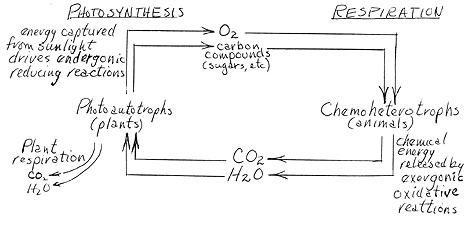
The oxidative chemical reactions of respiration release energy, some of which is heat and some of it is captured in the form of high energy compunds such as Adenosine triphosphate (ATP) and Nicotinamide adenide dinucleotide phosphate (NADPH). These compounds have a high energy (unstable) terminal phosphate bond and that terminal phosphate is easily detached with the transfer of the energy to drive chemical reactions in the synthesis of other biomolecules. In this case, the ATP loses one phosphate to become the energy-depleted ADP (Adenosine diphosphate) and the NADPH loses one electron to become energy-depleted NADP+.
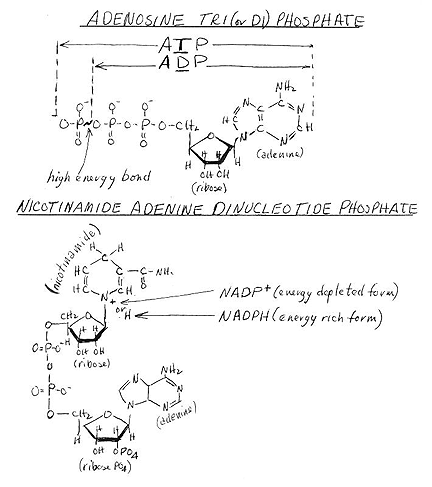
Photosynthesis converts these energy- depleted compounds (ADP and NADP+) back to the high energy forms (ATP and NADPH) and the energy thus produced in this chemical form is utilized to drive the chemical reactions necessary for synthesis of sugars and other carbon containing compounds (e.g., proteins, fats). The production of high energy ATP and NADPH in plants occurs in what is known as Light Phase Reactions (Z Scheme) (requires sunlight). The energy releasing reactions which converts them back to energy-depleted ADP and NADP is known as Dark Phase Reactions (Calvin Cycle) (does not require light) in which the synthesis of glucose and other carbohydrates occurs.
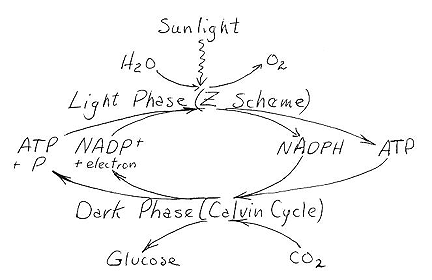
So we can summarize by saying that the photosynthetic plants trap solar energy to form ATP and NADPH (Light Phase) and then use these as the energy source to make carbohydrates and other biomolecules from carbon dioxide and water (Dark Phase), simultaneously releasing oxygen in to the atmosphere. The chemoheterotrophic animals reverse this process by using the oxygen to degrade the energy-rich organic products of photosynthesis to CO2 and water in order to generate ATP for their own synthesis of biomolecules.
Plant photosynthesis, both the Light Phase and Dark phase reactions, takes place in chloroplasts, which may be regarded as the "power plants" of the green leaf cells. At night, when there is no sunlight energy, ATP continues to be generated for the plant's needs by respiration, i.e., oxidation of (photosynthetically produced) carbohydrate in mitochondria (similar to animals).
Chloroplasts have many shapes in different species but are generally fusiform shaped (and much larger than mitochondria) and have many flattened membrane-surrounded vesicles called thylakoids which are arranged in stacks called grana. These thylakoid membranes contain all of the photosynthetic pigments of the chloroplast and all of the enzymes required for Light Phase reactions. The fluid in the stroma surrounding the thylakoid vesicles contains most of the enzymes for Dark phase reactions.
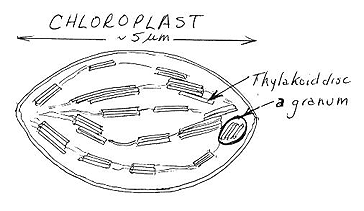
There are several light-absorbing pigments in the thylakoid membranes. The most important are the green chlorophylls which are complex protoporphyrin (resembles hemoglobin) molecules which have a magnesiun ion in the center. There are two types of chlorophyll: chlorophyll a, which is always present in all green plants, and a second, chlorophyll b which is also present (about half as much as chlorophyll a) in some plants. The chlorophylls are the major light receptors, absorbing light mostly in the 400 to 500 and 600 to 700 nanometer (nm.)wavelength ranges. The absorption spectra for chlorphylls a and b are shown below. Other pigmented compounds present in the thylakoid membranes include carotenoids (are red, yellow or purple), the most important of which is beta-carotene, the precursor of vitamin A in animals. The carotenoid pigments absorb sunlight at wavelengths other than those absorbed by the chlorophylls and thus are supplementary light receptors.
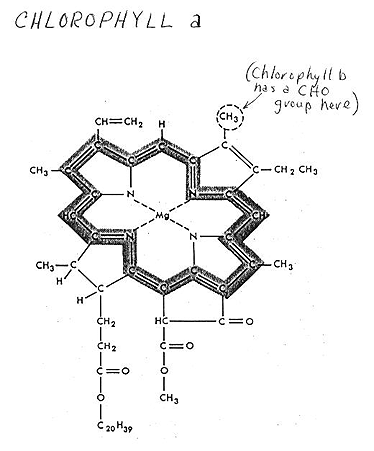
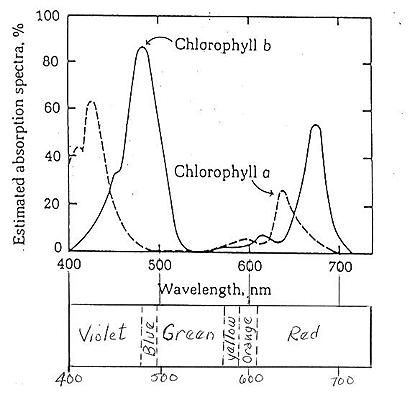
The thylakoid membranes of plant chloroplasts have two different sets of light harvesting chlorophyll and carotenoid molecules combined with a special protein.
There are two of these
Photochemical Reaction Centers:
Photosystem I : has a high ratio of chlorophyll a to
chlorophyll b.
Photosystem II : has relatively more chlorophyll b and
may also contain a chlorophyll c.
The plants and cyanobacteria (which use water as a hydrogen donor and produce oxygen) have Photosystems I and II, whereas the less highly evolved other photosynthetic bacteria(which do not use water as their hydgrogen donor and do not produce oxygen) have only Photosystem I.
How does the absorption of light by the chlorophyll pigments in the thylakoid membrane cause the conversion of light energy to chemical (ATP & NADHP) energy?
The quick answer is that an electron is stripped from water and transferred to NADP+ to form NADPH which is an endergonic (requires energy imput) reaction.That energy is supplied by the sunlight absorbed in the chloroplasts. And in the process, a phosphorus is added to ADP to produce ATP.
When the chlorophyll molecule is excited by light, the energy level of an electron in its structure is "boosted to a higher energy level and this "excited" chlorophyll (now is called an exciton) moves rapidly the the reaction center of the Photosystem I where it transfers its extra energy to an electron which is then expelled from the reaction center and is accepted by the first member of a chain of electron carriers and ultimately reaches NADP+, reducing it to NADPH. The reaction center has lost an electron and this "electron hole" is filled by by stripping electrons from water which leaves hydrogen ion (H+) and molecular oxygen (O2). The pathway of electrons from water to NADP+ has "Z" shape when diagramed and is refered to as the Z Scheme.
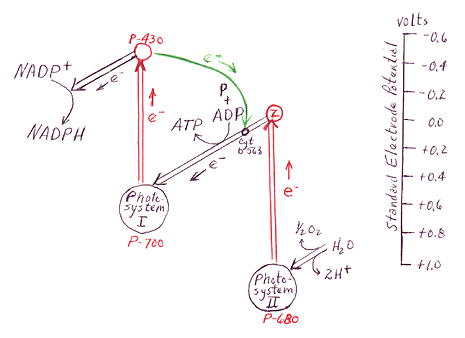
The Z Scheme diagram shows the pathway of an electron from water (lower right) to NADP+ (upper left). It also shows the energy relationships which are measured as voltage potential shown on the scaleon the right. To raise the energy of the electrons derived from water (+0.82 volts) to the level necessary to reduce NADP+ to NADPH (-0.32 volts), each electron must be boosted twice (vertical red arrows) by light energy absorbed in Photosystems I and II. After each boosting , the energized electrons flow "downhill" (diagonal black lines) and in the process transfer some of their energy to a series of reactions which ultimately adds a phosporus to ADP to produce high energy ATP and reduces NADP+ to NADPH. There is an alternative shunt whereby the electron flow turns back to cytochrome b563 (green line)and this is called cyclic electron flow and it occurs when there is no need for NADPH, so only ATP is produced.
How are the electrons lost from Photocenters replaced? The "electron hole" in Photosystem I is filled by the electron which was expelled by sunlight energy from Photosytem II and travels to Photosystem I via the chain of electron carriers (the right red vertical and right black diagonal lines). Then the resulting "electron hole" in Photosystem II is in turn filled by the splitting of water (by an enzyme named water dehydrogenase) into electrons and H+ ions and molecular oxygen. The electrons go to Photosystem II "electron holes" and the H+s go into the fluid medium and the oxygen is released into the air.
For each electron flowing from water to NADP+ (a net change in 1.14 volts), two quanta of light are absorbed, one by each Photosystem. Each molecule of oxygen released involves the flow of four electrons from two water molecules to two NADP+s and requires four quanta of sunlight absorbed by each Photosystem to provide the energy to do this. These are the "Light Phase Reactions" of photosynthesis, which produce two high energy chemical products, namely NADPH and ATP.
Now what are the "Dark Phase Reactions" (aka Calvin Cycle)? This is the cycle that converts CO2 into glucose. Since it utilizes the chemical energy in the ATP and NADPH, it does not require sunlight (hence the name). It is a complex cycle of mostly phosphorylation (adding or removing phosphate) and oxidative (electron removal) chemical reactions whereby 6 molecules of CO2 are converted into one molecule of glucose. It requires the energy-releasing cleavage of high energy bonds of 18 ATPs and 12 NADPHs . The resulting 18 ADPs and 12 NADP+s are then restored by the Light Phase process to their high energy forms (ATP and NADPH).
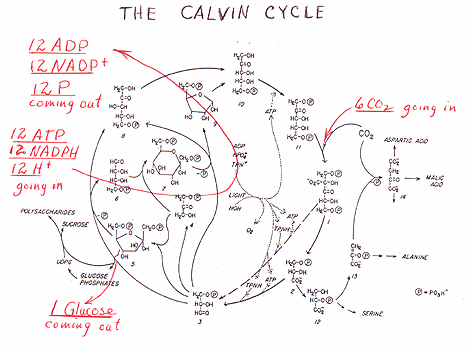
Therefor these two (Light and Dark) phases are interlinked and complimentary. And in the end, the plants have utilized the energy of sunlight to produce glucose (and ultimately other carbohydrates, proteins and fats) and oxygen from water and carbon dioxide.